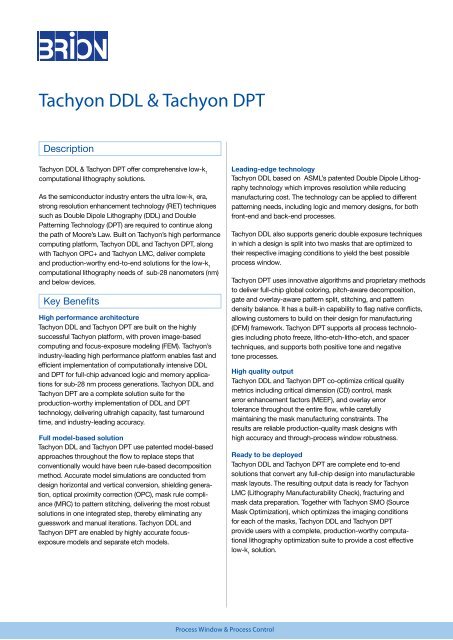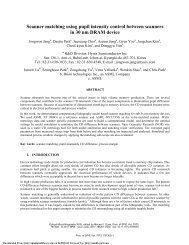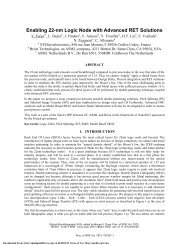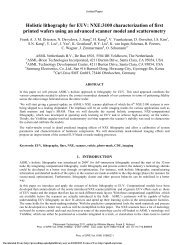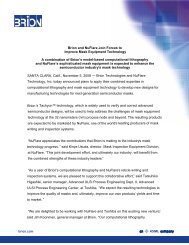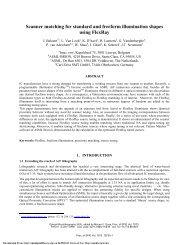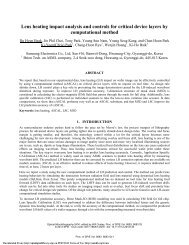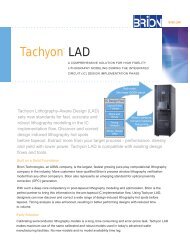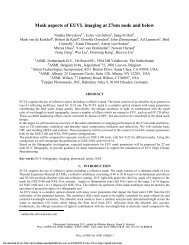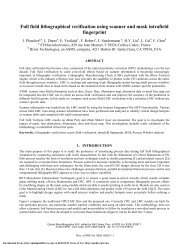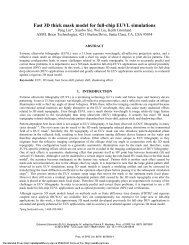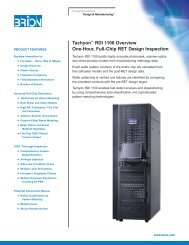Tachyon DDL & Tachyon DPT
Data Sheet (.pdf) - Brion Technologies, Inc.
Data Sheet (.pdf) - Brion Technologies, Inc.
- No tags were found...
You also want an ePaper? Increase the reach of your titles
YUMPU automatically turns print PDFs into web optimized ePapers that Google loves.
<strong>Tachyon</strong> <strong>DDL</strong> & <strong>Tachyon</strong> <strong>DPT</strong><br />
Description<br />
<strong>Tachyon</strong> <strong>DDL</strong> & <strong>Tachyon</strong> <strong>DPT</strong> offer comprehensive low-k 1<br />
computational lithography solutions.<br />
As the semiconductor industry enters the ultra low-k 1<br />
era,<br />
strong resolution enhancement technology (RET) techniques<br />
such as Double Dipole Lithography (<strong>DDL</strong>) and Double<br />
Patterning Technology (<strong>DPT</strong>) are required to continue along<br />
the path of Moore’s Law. Built on <strong>Tachyon</strong>’s high performance<br />
computing platform, <strong>Tachyon</strong> <strong>DDL</strong> and <strong>Tachyon</strong> <strong>DPT</strong>, along<br />
with <strong>Tachyon</strong> OPC+ and <strong>Tachyon</strong> LMC, deliver complete<br />
and production-worthy end-to-end solutions for the low-k 1<br />
computational lithography needs of sub-28 nanometers (nm)<br />
and below devices.<br />
Key Benefits<br />
High performance architecture<br />
<strong>Tachyon</strong> <strong>DDL</strong> and <strong>Tachyon</strong> <strong>DPT</strong> are built on the highly<br />
successful <strong>Tachyon</strong> platform, with proven image-based<br />
computing and focus-exposure modeling (FEM). <strong>Tachyon</strong>’s<br />
industry-leading high performance platform enables fast and<br />
efficient implementation of computationally intensive <strong>DDL</strong><br />
and <strong>DPT</strong> for full-chip advanced logic and memory applications<br />
for sub-28 nm process generations. <strong>Tachyon</strong> <strong>DDL</strong> and<br />
<strong>Tachyon</strong> <strong>DPT</strong> are a complete solution suite for the<br />
production-worthy implementation of <strong>DDL</strong> and <strong>DPT</strong><br />
technology, delivering ultrahigh capacity, fast turnaround<br />
time, and industry-leading accuracy.<br />
Full model-based solution<br />
<strong>Tachyon</strong> <strong>DDL</strong> and <strong>Tachyon</strong> <strong>DPT</strong> use patented model-based<br />
approaches throughout the flow to replace steps that<br />
conventionally would have been rule-based decomposition<br />
method. Accurate model simulations are conducted from<br />
design horizontal and vertical conversion, shielding generation,<br />
optical proximity correction (OPC), mask rule compliance<br />
(MRC) to pattern stitching, delivering the most robust<br />
solutions in one integrated step, thereby eliminating any<br />
guesswork and manual iterations. <strong>Tachyon</strong> <strong>DDL</strong> and<br />
<strong>Tachyon</strong> <strong>DPT</strong> are enabled by highly accurate focusexposure<br />
models and separate etch models.<br />
Leading-edge technology<br />
<strong>Tachyon</strong> <strong>DDL</strong> based on ASML’s patented Double Dipole Lithography<br />
technology which improves resolution while reducing<br />
manufacturing cost. The technology can be applied to different<br />
patterning needs, including logic and memory designs, for both<br />
front-end and back-end processes.<br />
<strong>Tachyon</strong> <strong>DDL</strong> also supports generic double exposure techniques<br />
in which a design is split into two masks that are optimized to<br />
their respective imaging conditions to yield the best possible<br />
process window.<br />
<strong>Tachyon</strong> <strong>DPT</strong> uses innovative algorithms and proprietary methods<br />
to deliver full-chip global coloring, pitch-aware decomposition,<br />
gate and overlay-aware pattern split, stitching, and pattern<br />
density balance. It has a built-in capability to flag native conflicts,<br />
allowing customers to build on their design for manufacturing<br />
(DFM) framework. <strong>Tachyon</strong> <strong>DPT</strong> supports all process technologies<br />
including photo freeze, litho-etch-litho-etch, and spacer<br />
techniques, and supports both positive tone and negative<br />
tone processes.<br />
High quality output<br />
<strong>Tachyon</strong> <strong>DDL</strong> and <strong>Tachyon</strong> <strong>DPT</strong> co-optimize critical quality<br />
metrics including critical dimension (CD) control, mask<br />
error enhancement factors (MEEF), and overlay error<br />
tolerance throughout the entire flow, while carefully<br />
maintaining the mask manufacturing constraints. The<br />
results are reliable production-quality mask designs with<br />
high accuracy and through-process window robustness.<br />
Ready to be deployed<br />
<strong>Tachyon</strong> <strong>DDL</strong> and <strong>Tachyon</strong> <strong>DPT</strong> are complete end to-end<br />
solutions that convert any full-chip design into manufacturable<br />
mask layouts. The resulting output data is ready for <strong>Tachyon</strong><br />
LMC (Lithography Manufacturability Check), fracturing and<br />
mask data preparation. Together with <strong>Tachyon</strong> SMO (Source<br />
Mask Optimization), which optimizes the imaging conditions<br />
for each of the masks, <strong>Tachyon</strong> <strong>DDL</strong> and <strong>Tachyon</strong> <strong>DPT</strong><br />
provide users with a complete, production-worthy computational<br />
lithography optimization suite to provide a cost effective<br />
low-k 1<br />
solution.<br />
Process Window & Process Control
Litho-etch<br />
M1 example:<br />
k 1<br />
= 0.31<br />
NA=1.2<br />
35 DX+DYX,Y<br />
polarization<br />
Litho-etch<br />
Poly example:<br />
k 1<br />
= 0.3<br />
NA=0.93<br />
NA, sigma out/sigma in=0.95/0.71,<br />
60 DX+DY, X,Y<br />
polarization<br />
<strong>Tachyon</strong> <strong>DDL</strong> uses model simulations and innovative algorithms to automatically decompose the design into two optimal masks which provide the best<br />
final image quality and process window robustness. The technique can be applied to both logic and memory style designs to achieve k 1<br />
< 0.3 imaging.<br />
<strong>Tachyon</strong> <strong>DPT</strong> performs global coloring,<br />
pattern split, model-based stitching<br />
compensation, SRAF placement, and<br />
model-based OPC all in one integrated flow,<br />
reducing the development and computational<br />
cost of implementing the technology.<br />
Process Window & Process Control
Functions and Features<br />
Double exposure lithography implementation<br />
• Supports ASML-patented double dipole<br />
lithography technology<br />
• Supports generic double exposure<br />
lithography technology<br />
• Complete model-based full-chip pattern decomposition<br />
• Source polarization for contrast improvement<br />
• Process window optimized SRAF placement and<br />
guaranteed SRAF non-printability<br />
• Binary,attenuated phase shift, and tri-tone masks<br />
• Simultaneous shielding and OPC optimization on<br />
two masks<br />
• Co-optimized shielding for optimal ILS and side<br />
lobe margin<br />
• Intelligent ripple control for complex 2D structures<br />
• Production proven<br />
Double patterning technology implementation<br />
• Full-chip Litho-<strong>DPT</strong> and Spacer-<strong>DPT</strong><br />
• Efficient full-chip global coloring without coloring<br />
conflict propagation<br />
• Programmable geometry specific coloring<br />
• Gate-aware pattern split<br />
• Pitch-aware coloring<br />
• Model-based and rule-based stitching compensation<br />
• Overlay error tolerant and MEEF-aware<br />
stitching compensation<br />
• Process window model-based OPC with resist and/or<br />
etch model<br />
• Automatic density balancing for contact Litho-<strong>DPT</strong><br />
• Native conflict identification and conflict loop analysis<br />
• Native conflict resolution for cell optimization<br />
• Supports positive tone and negative tone <strong>DPT</strong> processes<br />
Red: Pinching without overlay aware stitching<br />
Blue: Optimal contour with overlay aware stitching<br />
5 nm x overlay error 5 nm x and 5 nm overlay error<br />
Without proper overlay error tolerance stitching, small overlay errors<br />
combined with a slight defocus could result in serious pinching, thereby<br />
killing the device yield.<br />
split/stitch<br />
Production-ready quality<br />
• Process window-aware correction<br />
• Built-in MRC for output masks<br />
Efficiency and cycle time performance<br />
• Fully integrated (single step) flow on a common platform<br />
• Fully distributed layout decomposition and modelbased<br />
OPC<br />
• Hierarchical support for higher throughput<br />
• Built-in innovative algorithms for optimal cycle<br />
time performance<br />
Flexibility and ease of use<br />
• Full model-based approach that requires no fine tuning<br />
and maintaining of complex rules<br />
• Complete ready-to-use, built-in algorithms and optimal<br />
mask designs for robust process window<br />
• Fully parameterized user input and script-driven flow<br />
• Programmable customization via easy scripting to meet<br />
users’ special needs<br />
<strong>Tachyon</strong> <strong>DPT</strong> employs overlay error tolerance model-based stitching error<br />
compensation. The resulting design is free of overlay error induced issues under<br />
normal manufacturing conditions.<br />
Process Window & Process Control
22 nm<br />
NA=1.35<br />
sigma out/sigma in=0.77/0.97<br />
60 DX+DY<br />
Regular <strong>DDL</strong> Split and OPC<br />
<strong>DDL</strong> with Intelligent Ripple Control<br />
<strong>Tachyon</strong> <strong>DDL</strong>’s model-based shielding and intelligent ripple control overcomes the difficulty with the traditional rule-based splitting method to control<br />
the ripples in complex 2D structures<br />
<strong>DPT</strong><br />
SPT split<br />
Model-based<br />
OPC with<br />
overlay aware<br />
stitching<br />
<strong>Tachyon</strong><br />
LMC<br />
<strong>Tachyon</strong> <strong>DPT</strong> together <strong>Tachyon</strong> OPC+ and <strong>Tachyon</strong> LMC provides a complete spacer double patterning flow from mask split, mask correction,<br />
and overlay aware verification<br />
© 2010 Brion Technologies, Inc. All rights reserved.<br />
Brion Technologies, Inc. • Phone: +1 (408) 653-1500 • Email: info@brion.com • brion.com<br />
Process Window & Process Control


